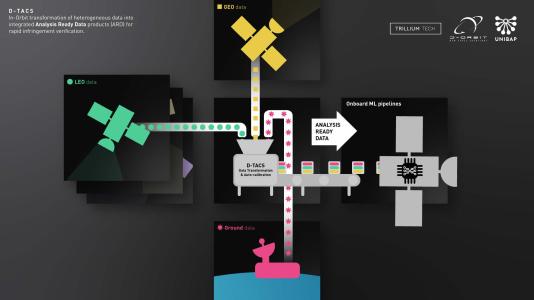D-TACS: on demand data transformations and auto-calibration in-orbit

Many use cases for insight generated in orbit require the integration and calibration of raw data from multiple instruments and vantage-points – a future vision sometimes referred to as ‘hybrid observation’. Such a capability would be a foundational requirement in the processing chain for rapid follow-up observations especially when we need to estimate quantitative variables (e.g. soil moisture or water pollutants). While this is normal practice on the ground, preparation of data to create Analysis Ready Data (ARD) products is laborious and time consuming, with ARD being calibrated and georeferenced before being integrated into machine learning (ML) pipelines. Fortunately, machine learning can be used to calibrate data by replacing computationally expensive transformations – such as atmospheric correction – with ML emulators.
This activity demonstrated a Data Transformation / Auto-Calibration System (D-TACS) running on D-Orbit’s growing constellation of ION spacecraft hosting the Nebula Space Cloud processing environment in partnership with Unibap. D-TACS would allow any application connected to Nebula to use ARD data for any downstream task if needed, amplifying its value as a node for hybrid observation strategies, particularly in cases where there has been instrument drift. In particular, in the envisioned onboard processing chain, each application would trigger a desired level of preprocessing before running and the onboard cloud computing service will be in charge of orchestrating these processes to avoid duplications and maximise efficiency. Potential use cases of this capability would be onboard processing of enhanced data from the Copernicus satellites at very low latency (where ML techniques can be very efficient) and integration of data from multiple sensors while in orbit. This would expand the range of onboard use cases – in particular, verification and measurement of subtle variables characteristic of vegetation, fire risk or fuel moisture.
